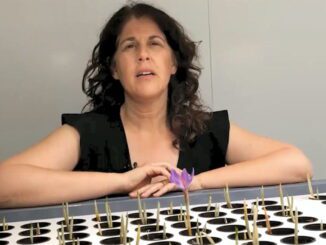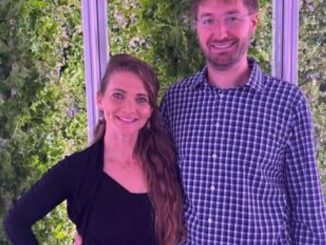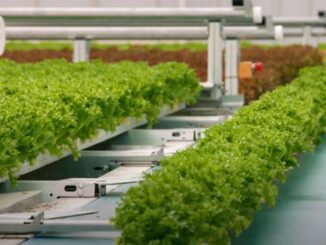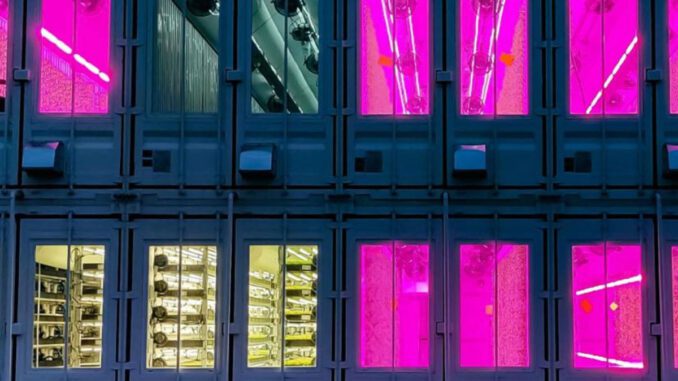
Going dark: Company explores indoor vertical farming without light
Heterotrophic Growing | Aaron Gonzalez |
IMAGE: Square Roots’ initiative explores the potential of growing plants without light, aiming to reduce the energy demands of indoor vertical farming significantly.
New York-based controlled environment agriculture company Square Roots has unveiled a program that aims to remove lighting from commercial indoor vertical farming systems to reduce energy demands and costs.
Through partnerships and focused research, the company says it is exploring techniques like heterotrophic growing to operate indoor farms in the dark, with the goal of lower production costs and environmental impact while maintaining year-round fresh food production.
“Over the last 12 months Square Roots has created a platform to accelerate agricultural research, working with partners across both indoor and outdoor farming, alongside science-focused organizations and foundations,” Square Roots co-founder and CEO Tobias Peggs told The Packer.
The program seeks to demonstrate that light can be removed from a commercial indoor vertical farming system; the benefits of indoor farming remain, but the system can now operate with radically reduced energy needs. This translates directly to significantly lower production costs and associated carbon dioxide equivalent, or CO2e, he said.
SCIENTIFIC BACKING, SUPPORTED BY COLLABORATION
To enable this new approach, Square Roots is working with gene-edited CRISPR plants that add biomass by uptaking carbon through their root systems rather than relying on photosynthesis under light. The underlying science was initially developed by Robert Jinkerson, a specialist in artificial photosynthesis at the University of California, Riverside, in conjunction with Feng Jiao, a chemist at the University of Delaware.
“They have been very successful with lab-scale trials in sustainable acetate production and heterotrophic plant growth,” Peggs said. “Now the Square Roots platform is being used to learn how to grow heterotrophically at production scale.”
The aim of the program is to develop a blueprint for low-cost, low-carbon indoor farms specifically designed to maximize the benefits of this technique, which could unlock the full potential of vertical farming for new crops and communities around the world, he said.
ENVIRONMENTAL BENEFITS
“Indoor farming companies tend to make many similar claims about environmental sustainability; CEA growers use less water and land than conventional field farms, as well as having shorter supply chains, reducing food miles and reducing associated emissions from transport,” Peggs said.
But there’s a lack of hard data or specific targets being mentioned. A recent Global CEA Census report warned of an industry “susceptible to excessive greenwashing,” he said.
The company recently completed a life-cycle analysis project to measure Scope 1, 2 and 3 emissions, in accordance with the GHG Protocol standards. This attempted to quantify the CO2e footprint across its entire operations, and then start developing specific plans for reduction.
“Interestingly, the largest segment of our emissions, at 47%, was the actual construction projects to build new farms. But when it came to day-to-day operations, by far the biggest issue was electricity consumption at 21%,” Peggs said. “The bulk of that came from lighting, but also the HVAC required to deal with the latent heat given off by those same lights.”
He said the heterotrophic growing trials were successful, and the company can show how to operate an indoor farming system with significantly less light and less energy, which will translate directly and quantifiably to lower emissions.
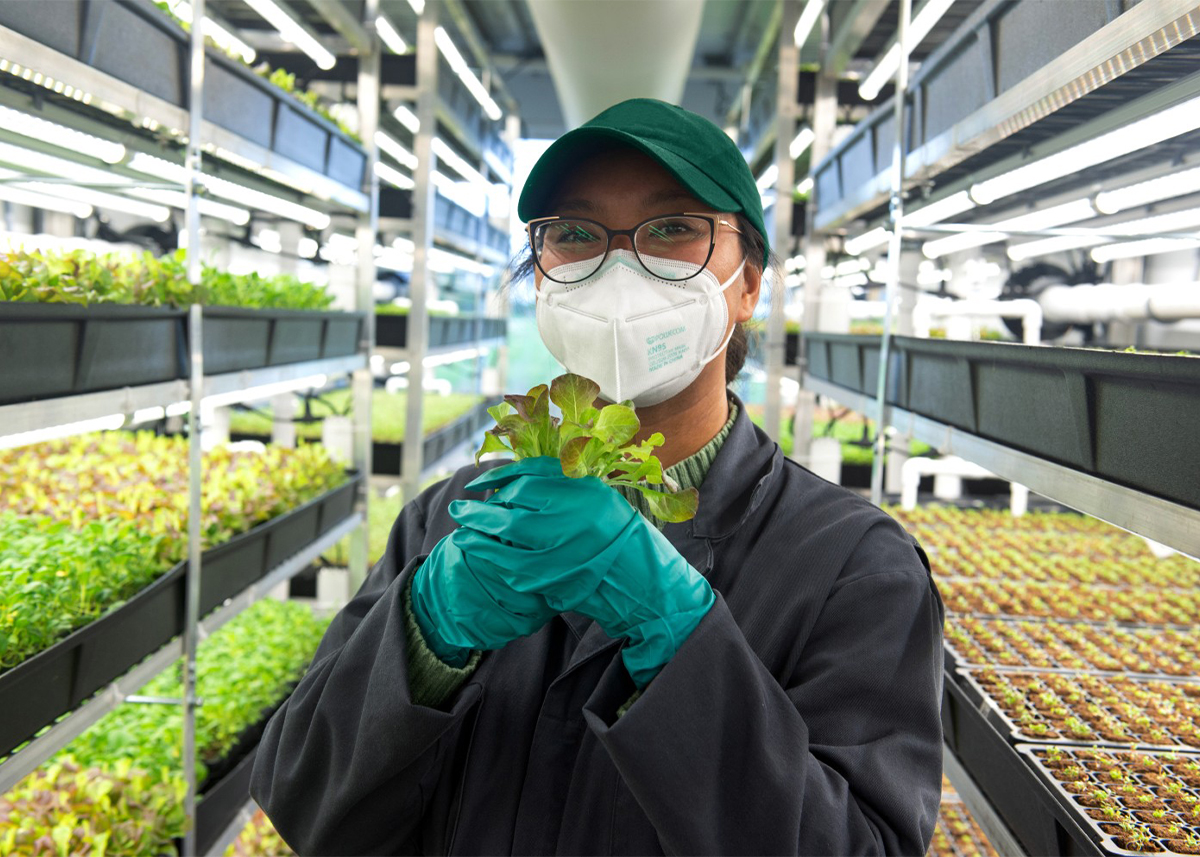
EXPLORING PRIMARY CROPS
Arabidopsis, a bitter green, was the first crop edited for acetate utilization by Jinkerson and his team, and its short growing time allows for faster cycles of research and analysis.
“This is helping us rapidly determine the necessary farm system adaptations needed to support and optimize for heterotrophic growth. These learnings are then being applied to trials with longer growing, higher calorie crops,” Peggs said.
The second phase of the program is running trials on lettuce, one of the most common crops grown in vertical farms.
Peggs said Square Roots has good benchmark data to compare the energy resources used between photosynthetic growth and heterotrophic growth, and it can also compare that readily with field-grown varieties. Lettuces have relatively fast growth cycles, so the company can rapidly iterate through multiple grow-recipes to capture yield data with different levels of acetate and light, including zero light, he said.
“We will also be looking closely at crop quality to determine market suitability of the end product,” Peggs said. “The science here is obviously very cool, but we have to ensure that the technique results in a product that is delicious, nutritious and that people want to eat.”
The third phase will be growing so-called SPACE (Small Plants for Space Expeditions) tomatoes. This variety has been edited to produce maximum fruit quickly in a compact structure and is well suited to high-density growing in vertical farms, he said.
“Tomatoes will allow us to progress to understanding light levels necessary for fruiting and flowering in a heterotrophic system. Also, tomatoes are an important global source of calories, representing 15% of total vegetable production,” Peggs said.
The long-term objective of the heterotrophic growing program is high-calorie, high-nutrient staple foods. From initial analysis, the company thinks that potatoes and cassava can be readily adapted to efficiently grow indoors using this technique.
“Because our platform is modular, we can run trials with different plants, and even different grow systems, in the same facility at the same time,” Peggs said. “For example, we might have an aeroponic system for heterotopic potato trials while we run lettuce trails concurrently in a hydroponic system.“
As the company extend its learning to other nutrient-dense crops, its platform can seamlessly adapt to accelerate that research, Peggs said.
THE FUTURE OF GLOBAL AGRICULTURE
Agriculture continues to face pressures from climate change and limited resources. At the same time, there is a need to feed a growing population while the reported average age of farmers globally seems to go rise almost every year.
“If you fast forward beyond the scope of this program, one can imagine a connected network of low-cost, low-carbon indoor farms across low- and middle-income countries, run by tech-savvy, data-driven farmers, producing staple crops year-round in sustainable and economically viable ways,” Peggs said.
The optimal farm model is to be determined, he said, noting that these future indoor farms perhaps are not growing plants to full maturity, but they’re taking advantage of heterotrophic growing — plus perfect climates and high-density planting — to become super-nurseries that produce healthy and hardy starter plans to improve success rates of outdoor farmers and ultimately improve outdoor yields.
“It’s exciting to think about the possibilities. For too long indoor farming has positioned itself as a disruptor to agriculture. We think CEA would do better helping to solve the big problems for agriculture instead of competing with it,” Peggs said.
That was a primary driver for setting up the Square Roots research platform, and this heterotrophic growing program demonstrates the power of that platform, he said.
Original Article: https://www.thepacker.com/news/sustainability/going-dark-company-explores-indoor-vertical-farming-without-light

